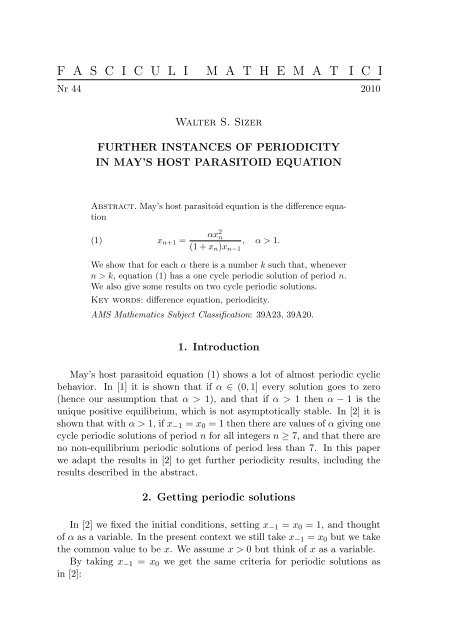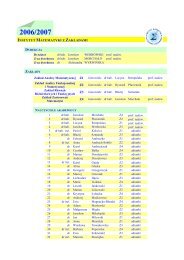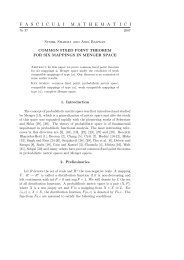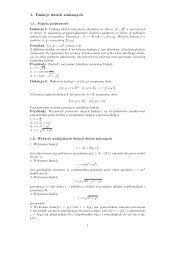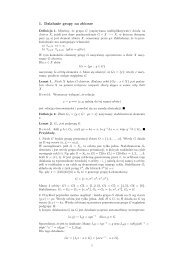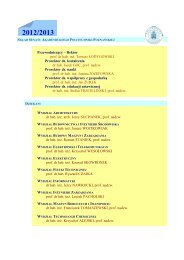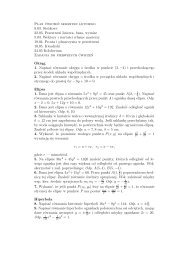F A S C I C U L I M A T H E M A T I C I
F A S C I C U L I M A T H E M A T I C I
F A S C I C U L I M A T H E M A T I C I
Create successful ePaper yourself
Turn your PDF publications into a flip-book with our unique Google optimized e-Paper software.
F A S C I C U L I M A T H E M A T I C INr 44 2010Walter S. SizerFURTHER INSTANCES OF PERIODICITYIN MAY’S HOST PARASITOID EQUATIONAbstract. May’s host parasitoid equation is the difference equation(1) x n+1 =αx 2 n(1 + x n )x n−1, α > 1.We show that for each α there is a number k such that, whenevern > k, equation (1) has a one cycle periodic solution of period n.We also give some results on two cycle periodic solutions.Key words: difference equation, periodicity.AMS Mathematics Subject Classification: 39A23, 39A20.1. IntroductionMay’s host parasitoid equation (1) shows a lot of almost periodic cyclicbehavior. In [1] it is shown that if α ∈ (0, 1] every solution goes to zero(hence our assumption that α > 1), and that if α > 1 then α − 1 is theunique positive equilibrium, which is not asymptotically stable. In [2] it isshown that with α > 1, if x −1 = x 0 = 1 then there are values of α giving onecycle periodic solutions of period n for all integers n ≥ 7, and that there areno non-equilibrium periodic solutions of period less than 7. In this paperwe adapt the results in [2] to get further periodicity results, including theresults described in the abstract.2. Getting periodic solutionsIn [2] we fixed the initial conditions, setting x −1 = x 0 = 1, and thoughtof α as a variable. In the present context we still take x −1 = x 0 but we takethe common value to be x. We assume x > 0 but think of x as a variable.By taking x −1 = x 0 we get the same criteria for periodic solutions asin [2]:
116 Walter S. SizerTheorem 1. Consider any difference equation which can be put in theform x n+1 x n−1 = f(x n ), and take x −1 = x 0 = x. For k ≥ 0(i) we get a periodic solution of period 2k + 2 if and only if x k = x k+1 ,and(ii) we get a periodic solution of period 2k + 3 if and only if x k = x k+2.Proof.situation.The proof of Theorem 1 of [2] is easily adapted to cover thisNote that this result applies to May’s host parasitoid equation.We can use (1) to compute a few values of x i :x 1 =x 2 =x 3 =x 4 =αx1+x ,α 3 x(1+x)(1+x+αx) ,α 6 x(1+x+αx)((1+x)(1+x+αx)+α 3 x) ,α 10 x(1+x)((1+x)(1+x+αx)+α 3 x)((1+x+αx)((1+x)(1+x+αx)+α 3 x)+α 6 x) .Direct computation using theorem 1 shows that there are no solutions toequation (1) with x −1 = x 0 of prime period 2, 3, 4, 5, or 6.With simplification, solutions of period 8 (where x 3 = x 4 ) correspond tosolutions of(2)0 = x 3 (α 2 + 2α + 1) + x 2 (−α 5 + α 3 + α 2 + 4α + 3) ++ x(α 6 − α 5 − 2α 4 + α 3 + 2α + 3) + (−α 4 + 1).We anticipate that one solution to this equation will correspond to theequilibrium of (1), the value x = α − 1. Thus x − (α − 1) will be a factor ofthe right hand side of (2); we factor it out and set the other factor equal tozero to get(3)0 = x 2 (α 2 + 2α + 1) + x(−α 5 + 2α 3 + 2α 2 + 3α + 2) ++ (α 3 + α 2 + α + 1).Descartes’ Rule of Signs tells us that if the x coefficient is greater thanor equal to 0 there are no positive solutions for x, and that there is onepositive value of α making this coefficient 0. This α value turns out to be2, and we see there are no periodic solutions of prime period 8 to equation(1) if α ≤ 2. If α > 2 solutions to (3) are given by the quadratic formula,and these are real only if ”b 2 − 4ac”≥ 0. This is the inequality(4) α 10 − 4α 8 − 4α 7 − 2α 6 + 4α 4 + 8α 3 + α 2 ≥ 0.Descartes’ Rule of Signs says the equation (4) has two or zero positiveroots; in fact, it has two, one less than 2 and one between 2.4 and 2.45.With the restriction α > 2 we get
Further instances of periodicity . . . 117Note 1. There is a number s between 2.4 and 2.45 such that equation(1) has a prime period 8 solution with x −1 = x 0 for α > s and not forα ≤ s. We get two solutions for x in these cases, corresponding to thevalues x −1 = x 0 and x 3 = x 4 above. For one of these values the sequencewill start out decreasing with x 0> x 1, and for the other it will start outincreasing.A similar but more difficult analysis showsNote 2. There is a number t between 4.0 and 4.1 such that equation (1)has a prime period 7 solution with x −1 = x 0 if and only if α > t. Again weget two values of x, one with the sequence starting out increasing and onewith the sequence starting out decreasing.In this case, after dividing out by the factor x − (α − 1), we want to solvethe equation(5)0 = x 4 (α 3 + 3α 2 + 3α + 1) + x 3 (2α 5 + 5α 4 + 6α 3 + 9α 2 + 10α + 4)+ x 2 (−α 8 + α 7 + 4α 6 + 5α 5 + 9α 4 + 10α 3 + 10α 2 + 12α + 6)+ x(α 7 + 4α 6 + 4α 5 + 5α 4 + 6α 3 + 5α 2 + 6α + 4)+ (α 6 + α 5 + α 4 + α 3 + α 2 + α + 1).Note 3. We can rewrite equations (3) and (5) thinking of α as thevariable and having coefficients involving x. Descartes’ Rule of Signs againsays that for fixed postitive x there is exactly one solution for α, and thissolution will be greater than 1. Thus for fixed x > 0 there will be oneand only one value of α > 1 so that May’s Host Parasitoid Equation has aperiodic solution of period 7 or 8 with x −1 = x 0 = x.3. Long decreasing sequencesAs in [2], the key to establishing periodicity results for longer periodslies in showing that there are solution sequences which start with arbitrarilymany decreasing terms. Specifically,Theorem 2. With May’s host parasitoid equation (1), for a fixed valueof α > 1 and for any natural number N, there is a number M such that forany value x > M, if x −1 = x 0 = x, then x 0 > x 1 > . . . > x N .(6)Proof. Rewriting (1) we getx n+1x n=Using (6) recursively we getα x n.(1 + x n ) x n−1
118 Walter S. Sizerorx n+1x n=α α(1 + x n ) (1 + x n−1 ) · · · α x 0,(1 + x 0 ) x −1α αx n+1 =(1 + x n ) (1 + x n−1 ) · · · α x 0x n .(1 + x 0 ) x −1Now we are assuming that x −1 = x 0 = x. Also, since x > 0 it follows1that x k > 0 for all k, so1+x k< 1. Thus x n+1 < αn+11+x x n. If we choosex > α N+1 − 1 = M, the theorem follows.Even though we get arbitrarily long decreasing sequences, it follows from[1] that every such sequence eventually stops decreasing–that is, there willbe some k with x k+1 > x k .4. Periodic solutionsWe now prove a theorem which will have as a corollary the existence ofmore periodic solutions in May’s host parasitoid equation.Theorem 3. Let the difference equation x n+1 x n−1 = f(x n ) involve aparameter c. Suppose f(x) is continuous in c for values of c in the intervalI, and that no value of c in I gives an equilibrium solution to the differenceequation. Suppose there are numbers a and b in I so that when c = a weget x −1 = x 0 > x 1 > x 2 > . . . > x m−1 , x m−1 < x m , and that when c = b weget x −1 = x 0 > x 1 > x 2 > . . . > x m+k . Then there are values of c givingperiodic solutions of periods 2m, 2m + 1, . . . , 2m + 2k − 1.Proof. Case 1: Even periods. Let n = 2l be in the list of periods above,so m ≤ l < m + k. Without loss of generality suppose b > a. Let X = {d ∣ for all c in [d, b], when c is used in f(x), x −1= x 0≥ x 1≥ . . . ≥ x l−1≥ x l}.Then X is non-empty as b is in X. Also X is bounded below by a. ThusX has a greatest lower bound L, which will be in I. We claim that whenc = L, x −1= x 0> x 1> . . . > x l−1= x l, so we get a periodic cycle of period2l by theorem 1. Since the values of x kare continuous in the parameter, bythe definition of X we conclude that for c = L we get(∗) x −1= x 0≥ x 1≥ . . . ≥ x l−1≥ x l.If we have x 0= x 1we have an equilibrium solution, but L ∈ I and novalue of c in I gives an equilibrium. Thus x 0> x 1. If we have x k= x k+1for 1 ≤ k < l − 1, then x k+2= x k−1because of the form of the differenceequation, and hence x k+2> x k+1, contradicting (∗). Thus we have x 0>x 1> . . . > x l−1. If also x l−1> x l, by the continuity of the x k’s we can findan interval [L−ɛ, L] in X, contradicting the statement that L is the greatest
Further instances of periodicity . . . 119lower bound of X. Thus x l−1= x land we get a periodic solution of period2l by Theorem 1.The case of odd periods is similarly proved using the set Y = {d ∣ for allc in [d, b], when c is used in f(x), x −1= x 0≥ x 1≥ . . . ≥ x l−1≥ x l, x l+1≥x l−1}.Corollary 1. Let α > 1 be fixed. There is a positive number N so thatfor all natural numbers n > N, May’s host parasitoid equation (1) has asingle cycle solution of period n.Proof. Our parameter c in the theorem is the value of x −1= x 0. Pick anx = a > α − 1. By Ladas et al. ([1]) the sequence we get is not (eventually)monotone, and since x 1= αx1+x < x = x 0 , this sequence must look like x −1 =x 0> x 1≥ x 2≥ . . . ≥ x k, x k< x k+1for some k. By theorem 2, for somelarger value of x, say x = b, we have x −1= x 0> x 1> . . . > x k> . . . > x n,where n can be chosen as large as we like. With I = [a, b] the hypotheses ofTheorem 3 are satisfied and we can thus get one cycle periodic solutions ofall periods greater than 2k + 1.Corollary 2. For all values of α greater than the number s in Note 1,there are periodic soluitions of prime period n for all values of n ≥ 8, andfor all values of α greater than the number t in Note 2, there are periodicsolutions of prime period n for all values of n ≥ 7.5. Two cycle periodic solutionsThe continuity of the functions x i can be further exploited to get twocycle periodic solutions:Theorem 4. (A) Consider α to be fixed. If there is a value of x (x = E)withE = x −1 = x 0 > x 1 > . . . > x k = x k+1(one cycle, period 2k+2)then there is a value of x giving a two cycle periodic solution of period 4k+5.(B) With α considered fixed, if there is a value of x (x = F ) withF = x −1 = x 0 > . . . > x k > x k+1 , x k = x k+2 , (one cycle, period 2k + 3)then there is a value of x giving a two cycle periodic solution of period 4k+7.Proof. (A) By Theorem 3 there is also a solution (x = E 1 > E) withE 1 = x −1 = x 0 > x 1 > . . . > x k > x k+1 , x k+2 = x k ,(one cycle, period 2k + 3).
120 Walter S. SizerLetS = {x ∣ ∣ x ≥ E, and for all y ∈ [E, x], if y = x−1 = x 0 ,then x 0 > x 1 > . . . > x k ≥ x k+1and x 2k+1 ≥ x 2k > x 2k−1 > . . . > x k+1 and x 2k+2 ≤ x 2k }.Then E ∈ S so S is non-empty, and E 1 /∈ S so S is bounded above.Again the least upper bound of S gives a solution with x 2k+2 = x 2k , that is,a solution of period 4k + 5. The symmetry of the solution before and afterx 2k = x 2k+2 shows that this solution consists of two cycles.(B) is proved similarly.Likewise we getTheorem 5. Consider α to be variable, α > 1, and take x −1 = x 0 = 1(as in [2]). Then for any odd integer n greater than or equal to 19 there isa value of α giving a two cycle period n solution.Proof. The proof is adapted from proofs in [2] in a manner similar tothe proof of Theorem 4. The requirement n ≥ 19 is added to avoid gettingthe equilibrium solution.Adapting the proof of theorem 4 to get periodic solutions of period k withn cycles, where k/n ≥ 7, seems a formidable task at best. It would seem adifferent, as yet untried, approach will be needed to prove this result.6. Problems1. (Ladas) For α > 1 and x −1, x 0> 0, show every solution to May’s hostparasitoid equation is bounded.2. Show that no two cycles in a given solution to equation (1) differ inlength by more than one element. (This could be used to solve problem 3).3. Show that for some values of α equation (1) has periodic solutions ofperiod k with n cycles whenever k/n ≥ 7.Also see [2].References[1] Ladas G., Tovbis A., Tzanetopoulos G., On May’s host parasitoidmodel, Journal of Difference Equations and Applications, 2(1996), 195-204.[2] Sizer W.S., Periodicity in May’s host parasitoid equation, Advances in DiscreteDynamical Systems, S. Elaydi et al., eds, Tokyo: Mathematical Societyof Japan, (2009), 333-337.
Further instances of periodicity . . . 121Walter S. SizerMinnesota State University Moorheade-mail: sizer@mnstate.eduReceived on 19.06.2009 and, in revised form, on 09.09.2009.


